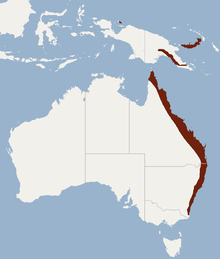Golden-tipped bat
| Golden-tipped bat | |
|---|---|
| Scientific classification | |
| Kingdom: | Animalia |
| Phylum: | Chordata |
| Class: | Mammalia |
| Order: | Chiroptera |
| Family: | Vespertilionidae |
| Genus: | Kerivoula |
| Species: | K. papuensis |
| Binomial name | |
| Kerivoula papuensis Dobson, 1878 | |
 | |
| Synonyms | |
|
Kerivoula papuensis (Dobson, 1878) | |
The golden-tipped bat (Kerivoula papuensis) is a species of Microchiropteran in the family Vespertilionidae.[1] It is found in Papua New Guinea and in Australia, especially scattered along the eastern part of Australia.[2] The species is considered uncommon,[3] and is listed as endangered in Australia.[4]
Description
The genus is large, with species ranging from small to medium in size.[3] The golden-tipped bat has brown color and broken color patterns on its pelage;[2] the body is covered with woolly fur.[4] Broken color patterns support crypsis in the golden-tipped bat;[4] thick pelage and wooly fur provide thermal insulation.[4] The average weight of adults is 6.7g.[4]
The wings of the golden-tipped bat show a low aspect ratio, with low wing loading. (That is, the wing is broad.) These wing features of support slow flight.[5][6] Additionally, the large tail membrane aids the wing membrane in enabling tight turns in flight.[5][6] Rounded wing tips also contribute to high maneuverability in flight.[5][6]
The golden-tipped bat also uses echolocation for foraging, with frequencies of approximately 155 kHz to 60 kHz.[5]
Habitat & Ecology
Most data about the golden tipped bats have been recorded in Australia and Papua New Guinea.[2] Recently, from the distributed areas of western coast of Australia, scientist could capture more species than in the past (1980s and '90s) by using newly developed techniques such as sonar detection systems.[2] Predominantly, the golden-tipped bat has been recorded in a variety of rainforest sites or wet sclerophyll forest.[2] Also a small number of individual records in dry sclerophyll forest. They live at elevations up to 1,000m.[2]
Roosting
A roost is an important resource for the golden-tipped bat.[4] They make diurnal roosts ranging from 0.5 to 9.0m above the ground,[4] roosting on the branches of the tree or in tree hollows.[4] Female bats use the canopy of a tree for a maternity site;[4] this siting helps them to lactate.[4] The large numbers of diurnal roosts are taken by single males or females, and some group roosts are bigger than the single roosts.[4]
Roosts, and their broken patterns of pelage, enable this species to camouflage against their predators.[4]
Diet & foraging strategies
Diet
Araneida such as orb-weaver and big-jawed spiders are the main food of golden-tipped bats; as shown by the high proportion of Araneida body fragments among the particles lodged among the bats' teeth and fur.[5] Araneida can be consumed by golden-tipped bat in both wet and dry roasting.
[5] Even though Araneida is a major food source for the golden-tipped bat, these bats also consume insects which belong to coleoptera (beetles) and lepidoptera (insect) [5]
Foraging strategies
The golden-tipped bat uses foraging strategies to hunt preys. One is ground gleaning so the golden-tipped bat catch the preys which are on the ground.[5] The other one is hover-gleaning strategy so they fly slowly and take preys which are on the elevated places such as high tree trunks.[5] The last one is using echolocation. The golden tipped bat use broad bandwidth echolocation to find precise localization of a target. Additionally, they use high frequencies echolocation to find the stationary prey such as spider staying in quiet web.[5]
References
- ↑ Parnaby, H; Mills, D (December 1994). "A Record of the Gold-tipped Bat from the Escarpment Forests". Australian Zoologist. 29: 3–4.
- 1 2 3 4 5 6 "The Action Plan for Australian Bats". Environment Australia. Missing or empty
|url=(help) - 1 2 SCHULZ, M (1995). "Utilisation of suspended bird nests by the Golden-tipped Bat (kerivoula papuensis) in Australia". mammalia. 59 (2): 280–283.
- 1 2 3 4 5 6 7 8 9 10 11 12 Schulz, M. "Roosts used by the golden-tipped bat Kerivoula papuensis (Chiroptera: Vespertilionidae)". J. Zoology Journal of Zoology. 250 (17 May 1999): 467–478.
|access-date=requires|url=(help) - 1 2 3 4 5 6 7 8 9 10 SCHULZ, MARTIN. "DIET AND FORAGING BEHAVIOR OF THE GOLDEN-TIPPED BAT,". Journal of Mammalogy. 81 (20 March 2000): 948–957. doi:10.1644/1545-1542(2000)081<0948:dafbot>2.0.co;2.
- 1 2 3 Rhodes, Martin (1995). "Wing Morphology and Flight Behaviour of the Golden-tipped Bat, Phoniscus papuensis(Dobson) (Chiroptera:Vespertilionidae)". Australia.Z.Zoo. 43: 657–63. doi:10.1071/zo9950657.
